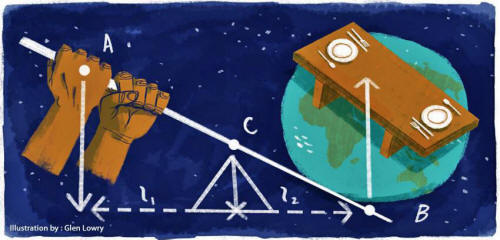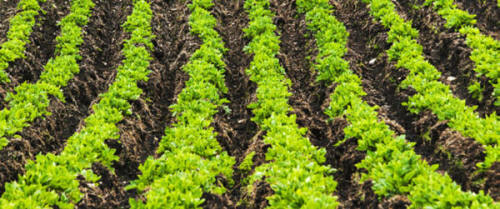
July 17, 2014
from
PHYS
Website

A few key leverage points
disproportionately offer the
best chances
to improve both global food
security
and environmental
sustainability.
Credit: Glen Lowry
Feeding a growing human population without increasing stresses on Earth's
strained land and water resources may seem like an impossible challenge.
But according to a new report by researchers at
the University of Minnesota's Institute on the Environment, focusing efforts
to improve food systems on a few specific regions, crops and actions could
make it possible to both meet the basic needs of 3 billion more people and
decrease agriculture's environmental footprint.
The report (Leverage
Points for Improving Global Food Security
and The Environment), published today in Science, focuses on 17 key crops that produce
86 percent of the world's crop calories and account for most irrigation and
fertilizer consumption on a global scale.
It proposes a set of key actions in three broad
areas that that have the greatest potential for reducing the adverse
environmental impacts of agriculture and boosting our ability meet global
food needs.
For each, it identifies specific "leverage
points" where nongovernmental organizations, foundations, governments,
businesses and citizens can target food-security efforts for the greatest
impact.
The biggest opportunities cluster in six
countries,
-
China
-
India
-
U.S.
-
Brazil
-
Indonesia
-
Pakistan,
...along with
Europe.
"This paper represents an important next
step beyond previous studies that have broadly outlined strategies for
sustainably feeding people," said lead author Paul West, co-director of
the Institute on the Environment's Global Landscapes Initiative.
"By pointing out specifically what we can do
and where, it gives funders and policy makers the information they need
to target their activities for the greatest good."
The major areas of opportunity and key leverage
points for improving the efficiency and sustainability of global food
production are:
-
Produce more food on existing land
Previous research has detected the
presence of a dramatic agricultural "yield gap" - difference between
potential and actual crop yield - in many parts of the world.
This study found that closing even 50
percent of the gap in regions with the widest gaps could provide
enough calories to feed 850 million people.
Nearly half of the potential gains are
in Africa, with most of the rest represented by Asia and Eastern
Europe.
-
Grow crops more efficiently
The study identified where major
opportunities exist to reduce climate impacts and improve the
efficiency with which we use nutrients and water to grow crops.
Agriculture is responsible for 20 to 35 percent of global greenhouse
gas emissions, largely in the form of carbon dioxide from tropical
deforestation, methane from livestock and rice growing, and nitrous
oxide from crop fertilization.
The study found that the biggest
opportunities for reducing greenhouse gas production are in,
-
Brazil
and Indonesia for deforestation
-
China and India for rice
production
-
China, India and the United States for crop
fertilization

The majority of
global environmental effects of agriculture
are concentrated in a
few countries, driven by a few commodities.
Targeting efforts in
these areas offers the greatest opportunity for
building a
sustainable global food system
by decreasing
greenhouse gas production,
improving irrigation
efficiency
and reducing excess
fertilizer use.
Credit: West et al.,
Science/AAAS
With respect to nutrient use, the study found that worldwide, 60
percent of nitrogen and nearly 50 percent of phosphorus applications
exceed what crops need to grow.
China, India and the U.S. - and
three crops, rice, wheat and corn - are the biggest sources of
excess nutrient use worldwide, so offer the greatest opportunity for
improvement.
With respect to water, rice and wheat are the crops that create the
most demand for irrigation worldwide, and India, Pakistan, China and
the U.S. account for the bulk of irrigation water use in
water-limited areas.
Boosting crop water use efficiency, the
researchers found, could reduce water demand 8 to 15 percent without
compromising food production.
-
Use crops more efficiently
The third major category of
opportunities characterized for boosting food production and
environmental protection relate to making more crop calories
available for human consumption by shifting crops from livestock to
humans and reducing food waste.
The crop calories we currently feed to animals are sufficient to
meet the calorie needs of 4 billion people. The study noted that the
U.S., China and Western Europe account for the bulk of this "diet
gap," with corn the main crop being diverted to animal feed.
Although cultural preferences and
politics limit the ability to change this picture, the authors note
that shifting crops from animal feed to human food could serve as a
"safety net" when weather or pests create shortages.
In addition, some 30 to 50 percent of food is
wasted worldwide.
Particularly significant is the impact of animal
products:
The loss of 1 kilogram of boneless beef has
the same effect as wasting 24 kilograms of wheat due to inefficiencies
in converting grain to meat.
The authors illustrate how food waste in the
U.S., China and India affect available calories, noting that reducing waste
in these three countries alone could yield food for more than 400 million
people.
"Sustainably feeding people today and in the
future is one of humanity's grand challenges.
Agriculture is the main source of water use,
greenhouse gas emissions, and habitat loss, yet we need to grow more
food," West said. "Fortunately, the opportunities to have a global
impact and move in the right direction are clustered.
By focusing on areas, crops and practices
with the most to be gained, companies, governments, NGOs and others can
ensure that their efforts are being targeted in a way that best
accomplishes the common and critically important goal of feeding the
world while protecting the environment.
Of course, while calories are a key measure
of improving food security, nutrition, access and cultural preferences
must also be addressed. But the need to boost food security is high.
So let's do it."
We Have Enough Land to...
Feed our
Growing Population
-
We Just Have to Use it Right - Study Finds
-
by Katherine Boehrer
July 17, 2014
from
TheHuffingtonPost Website

By some assessments, the human population
will require twice as much food in 2050 as we do now.
Some have estimated that an area the
size of South Africa or Canada would need to be planted to produce
enough food to meet these needs. But a new study says that may not be the
case.
According to
the study (Leverage
Points for Improving Global Food Security
and The Environment), published in the journal Science, growing more food doesn't
always require more crop-land - just a change in the way we use resources.
The authors looked at 17 of the most important
crops to analyze specific strategies to meet the needs of an additional
three billion people. It's not all about increasing growing efficiency
either - the study targets food waste and the amount of crops used to feed
animals.
The study makes specific suggestions about a few
key "leverage points" and Paul West, the study's lead author, said in
a press release that they are giving "funders and policy makers the
information they need to target their activities for the greatest good."

The majority of environmental effects of
agriculture
are concentrated in a few countries,
driven by select commodities, the study says.
Targeting efforts in these areas offers the
greatest opportunity
for building a sustainable global food system
by decreasing greenhouse gas production,
improving irrigation efficiency
and reducing excess fertilizer use.
Increasing food production while decreasing
environmental impact won't be easy, the authors say.
The study points to the idea of increasing yield
in countries that are not at their maximum potential yield. Bringing
low-performing countries up to just 50 percent of their full potential could
help feed 850 million people.
Increasing production while protecting the
environment would entail reducing the amount of wasted resources, such as
nitrogen and phosphorous fertilizers. It would also require a reduction in
the amount of water wasted. Cutting down on food waste is a must as well,
since upwards of
30 to 50 percent of food is wasted.
Shockingly, the researchers also point out that we could increase the amount
of food calories available by 70 percent if we diverted crops used to feed
animals directly to feeding humans,
enough to feed four billion people.
The authors do recognize the cultural and
political barriers to this route, but note that it could be used as a safety
net in food production.
One of the main points of this study is that
these changes could occur in a geographically limited area and focus on a
small number of worst offenders. Three countries - China, India and the
United States - are responsible for 64 to 66 percent of excess nutrient
application and globally.
Reducing food waste in these three countries
alone could be enough to feed an additional 400 million people. At the same
time, just three crops account for almost a third of excess nutrient
application, while two crops, rice and wheat, account for the vast majority
of water use.
Making food production more efficient can also
reduce greenhouse gas emissions by reducing deforestation and nitrous oxide
emissions from excess fertilizer and manure use, the study says.
That's not to mention the habitat saved by
reducing the amount of land cleared for new agriculture.
The researchers conclude,
"These leverage points in the global food
system can help guide how nongovernmental organizations, foundations,
governments, citizens' groups, and businesses prioritize actions."
Leverage
Points for Improving Global Food Security
and The Environment




